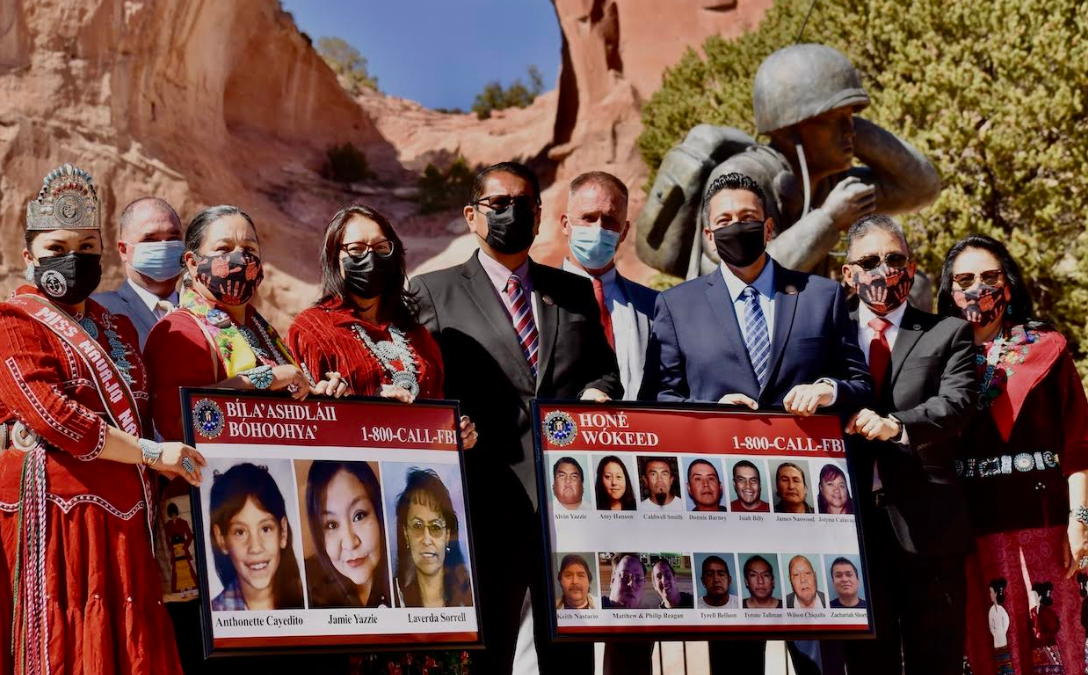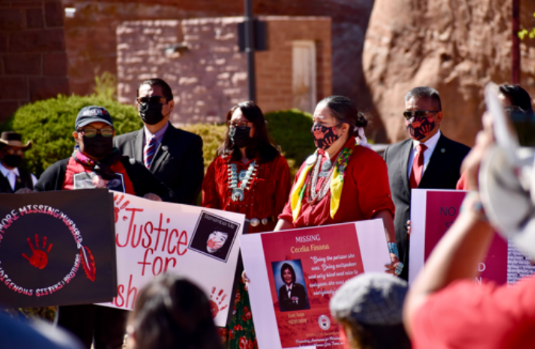
- Details
- By Native News Online Staff
WINDOW ROCK, Ariz. — Honoring and remembering missing and murdered Indigenous persons on the Navajo Nation, Navajo Nation President Jonathan Nez and Vice President Myron Lizer signed a proclamation recognizing May 5, 2021, as "Navajo Nation Missing and Murdered Indigenous Peoples Awareness Day.”
The leaders were joined by their respective wives, First Lady Phefelia Nez, and Second Lady Dottie Lizer, at the Navajo Nation Veterans Memorial Park in Window Rock, Ariz. Also in attendance were the 24th Navajo Nation Council’s Sexual Assault Prevention Subcommittee Chair Amber Kanazbah Crotty, Miss Navajo Nation Shaandiin Parrish, and the Albuquerque Federal Bureau of Investigations (FBI) Field Office.
"Today, we extend our appreciation to our partners and volunteers, who work hard to gather data, provide testimonies, analyze data, and provide recommendations regarding the Missing and Murdered Indigenous Women and Relatives crisis that affects each of our lives and tribal communities. Most importantly, we come together today to support and pray for survivors and victims," President Nez said.
During the visit, Albuquerque FBI Special Agent in Charge Raul Bujanda also met with Navajo Nation leaders to review the roles of the FBI in working with federal, tribal, and state agencies for responding to reports of missing and murdered Indigenous people.

“Setting aside a day to remember murdered and missing Native Americans is an opportunity for the FBI and our partners to reaffirm our commitment to bring justice to the victims and their loved ones,” Special Agent in Charge Bujanda said. “We also offer our condolences to the families and friends of all the victims. The FBI values its strong relationship with the Navajo Nation as we continue to work together to make our communities safer."
The proclamation states that the National Crime Information Center reported in 2016 that over 5,700 Native American Women and Girls were classified as missing while at the same time the United States Department of Justice missing person database reported only 116 missing Native American Women and Girls. Overall, Native Americans face murder rates that are more than the national average murder rate.
Sexual Assault Prevention Subcommittee Chair Amber Kanazbah Crotty acknowledged the long history of the missing and murdered Indigenous peoples and its devastating impacts on various groups of people including veterans and transgender and LGBTQ people who are often not included in data that is gathered. She also called for more data sharing among law enforcement agencies and offered support for the establishment of a Missing Persons Unit.
“This is a crisis, our missing and murdered Diné relatives. We know there are relatives that are still out there that are not accounted for. So many times, families are out there searching and they feel isolated and they feel a sense of blame and shame, but we stand with them. Whether it’s 15 years, 30 years since a loved one has gone missing, the families still feel the loss and the pain. It’s really through working together and through communication that we begin to heal,” Navajo Nation Delegate Crotty stated.
Following the ceremony, President Nez and Vice President Lizer joined Delegate Crotty and members of the 24th Navajo Nation Council outside of the Council Chamber as they gathered with families of missing and murdered relatives to offer support and to remember victims. Delegate Crotty also led an awareness walk with the families.
More Stories Like This
Native News Weekly (August 25, 2024): D.C. BriefsUS Presidents in Their Own Words Concerning American Indians
Navajo Man Faces Vehicular Homicide Charge After Child Killed at Navajo Nation Christmas Parade
Next on Native Bidaské: Lumbee Tribal Chairman John Lowery
Suspected Drunk Driver Crashes into Parade in Kayenta on Navajo Nation, Killing 1 & Injuring 3 Others
Help us defend tribal sovereignty.
At Native News Online, our mission is rooted in telling the stories that strengthen sovereignty and uplift Indigenous voices — not just at year’s end, but every single day.
Because of your generosity last year, we were able to keep our reporters on the ground in tribal communities, at national gatherings and in the halls of Congress — covering the issues that matter most to Indian Country: sovereignty, culture, education, health and economic opportunity.
That support sustained us through a tough year in 2025. Now, as we look to the year ahead, we need your help right now to ensure warrior journalism remains strong — reporting that defends tribal sovereignty, amplifies Native truth, and holds power accountable.
 The stakes couldn't be higher. Your support keeps Native voices heard, Native stories told and Native sovereignty defended.
The stakes couldn't be higher. Your support keeps Native voices heard, Native stories told and Native sovereignty defended.
Stand with Warrior Journalism today.
Levi Rickert (Potawatomi), Editor & Publisher

